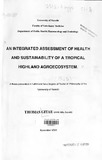| dc.description.abstract | A process was designed to assess the health and sustainability of a tropical-highland, smallholderdominated
agroecosystem. Twelve study sites within the agroecosystem were selected in a
multistage, purposive sampling protocol. Six of the study sites were designated "intensive" (ISS).
In these, some agroecosystem health and sustainability remedial measures were instituted. The
other six study sites were designated "extensive" (ESS) and were used to cross-validate the
indicators and to provide statistical power.
Communities in the ISS were included in the health and sustainability assessment. Participatory
action-research methods were used for that purpose. Human activity systems were modeled and
analyzed using soft systems methods. Relationships among agroecosystem and sustainability
factors were explored using loop models, graph theory and pulse process models. Conventional
observational study methods were used to study land-use units (LUU).
Two sets of health and sustainability indicators were developed. One set - the community driven
suite of indicators - was developed by the communities in the ISS as a list of measures that
would help them assess their agroecosystem. These indicators were used to develop a
community-based agroecosystem health and sustainability monitoring system. The other set of
indicators - the research-based suite - was developed by a multi-disciplinary team of researcherse'
Multiple correspondence analysis was used to further refine this suite of indicators and to
develop a basis for their interpretation.
Although the process used in this study was similar in some ways to traditional approaches in
research and development, there was an important departure in that communities were part of
the analytical processes. In addition, the entire process was grounded in a unifying theoretical
background that facilitated a holistic analysis. More important, however, is that communities
were able to use the concept of health to discuss and model approaches to better their
livelihoods. The approach provided a simple, yet highly specialized language - understood by the
communities, researchers, extension agents, development agents and policy makers - for
discussing issues of health and sustainability of agroecosystems and for structuring the process
through which remedial actions could be undertaken.
Research-based indicators differed in several important aspects from the community-driven
ones. Researcher-proposed indicators focused mostly on numeric, non-value-based measures.
This suite had a dearth of suitable social, and less so economic, indicators. In contrast,
community-based indicators were more strongly value-based, focusing mostly on a socialeconomic
interpretation of the underlying biophysical phenomena. The community-based suite
contained many indictors suitable for assessing many of the attributes in the social and economic
1I1I11/CDCfTV m- if A .n,...,....
domains. The suites were fO\.U1dto be complementary with researchers requiring some of the
data gathered using the community indicators and vice versa. Because of the short span of the
project, it is difficult to assess the construct validity of the indicator suites. However, the fact that
communities, policy makers and researchers are using information derived from these indicators
in making decisions about Kiambu suggests that these measures are useful. In addition, several
remedial actions taken as a result of monitoring using these indicators seem to be a move
towards sustainability and better agroecosystem health.
Multiple Correspondence Analysis was fO\.U1dto be a useful method of summarizing and
presenting data from indicators. Graphical techniques in conjunction with simple conceptual
models were also fO\.U1dto be useful. A meaningful assessment of health and sustainability of
Kiambu would require longitudinal studies over several years. However, time-dynamic models
can be used to project trends in some of the key agroecosystem health attributes under various
possible scenarios. The use of pulse-process models for this purpose was explored and fO\.U1d
potentially useful.
Goals and objectives of fanners and communities indicate a strong affinity to farming. With an
average per-capita fann income of 1339.77 ± 179.43 shillings per annum (US$17.63 ±2.36), this
affinity did not seem to be based on the economic returns, but more on socio-cultural affinity to
farming. In contrast, the average monthly wage was 6537.11 ± 1179.47 shillings, although onl~,
an average of 16% of the adults in a household were wage earners. The key constraint to health
appeared to be mainly related to infrastructural and policy inadequacies. With effort,
communities were able to make changes and some of the problems were solved. At this stage,
however, these appeared to be more of a reaction to immediate needs rather than long-term
strategies.
Community inertia was mostly attributed to an inability of communities to influence decisionmaking
and policy. Development agenda was seen as being based on considerations other than
the needs and aspirations of the communities. In addition, there were both socio-cultural and
legal impediments to communities setting - and working towards - reasonable goals for their
own agroecosystems. Examples are the regulation of coffee and tea production and marketing,
centralized planning and management of health services, and lack of community involvement in
the maintenance of the road networks. Another reason could be that in most cases, community
expectations far outstrip the outcomes for a given objective. An example is Githima village
where construction of additional classrooms was expected to result in increased literacy levels in
the same time span as it takes increased fann productivity to result in increased incomes. Such
imbalances can only lead to a great deal of frustration and inertia. On the other hand, the ease
with which communities were able to construct detailed cognitive maps and take some remedial
actions suggests the existence of a collective understanding and capacity for consensus-building
xviii
and collective action. Coupled with the fact that communities were highly receptive to the
concepts of action-research, collective planning, monitoring and evaluation, this could be
interpreted as indicative of a great potential for improved health and sustainability for these
communities given certain institutional and policy changes as well as expert support. | en |

